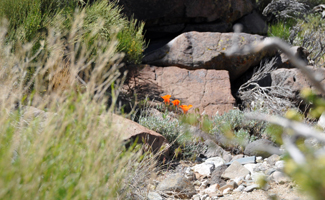 The majority of the land at NAWS China Lake is undeveloped and provides habitat for more than 340 species of wildlife, including wild horses and burros and endangered animals, such as the desert tortoise and Mohave Tui Chub . The installation is also home to 650 plant types.
The majority of the land at NAWS China Lake is undeveloped and provides habitat for more than 340 species of wildlife, including wild horses and burros and endangered animals, such as the desert tortoise and Mohave Tui Chub . The installation is also home to 650 plant types.
Safety Tips: Spring in China Lake
Our spring season normally brings out many of our desert creatures that have been dormant all winter, such as ground squirrels, kangaroo rats, lizards, etc. When these creatures emerge, so do snakes. This year, with our abundant spring rains, we can expect a boom in the populations of the snake’s favorite snacks, and consequently, a boom in the snake population. While snakes don’t like humans, humans tend to provide ample places for snakes to hunt and hide. Avoiding a venomous snakebite can be as simple as staying alert and aware. Pay attention when walking in the desert, working in your backyard, or even just finding a nice shady area outside to sit down and rest. During the hot part of the day, a snake may be in that same shady spot you may have chosen to rest and get out of the sun. In most snakebite cases, the victim placed his/her hands into an area that was not first visually cleared as safe. If you must place your hands where you cannot clearly see is safe, use a long stick to clear the area first. A rattlesnake does not always rattle before it strikes, so never depend on hearing a snake to ensure that it is a safe area. Always be alert when walking, riding, or exploring the desert. If you do see a snake, leave it alone, calmly leave the immediate area, and call China Lake Police at 939-3172. CLPD officers will ensure the area the snake is in stays clear while pest control responds to remove the snake. For snake removal, call Alutiiq at (760) 375-9503, or for after-hours snake removal, (760) 793-5924.
In the event of an actual snakebite, the first thing to do is stay calm. Immediately retreat out of the snake’s striking range and obtain medical assistance as soon as possible. If possible, pay attention to what the snake looks like to help with identification of the kind of snake you were in contact with. While some snakebites may be dry (i.e., no venom injected) it is important to seek medical attention for any bite, even without obvious or immediate evidence of a venom injection. If needed, simple first aid procedures can be done while waiting for advanced medical care. Immobilize the extremity at or below heart level to make the spread of venom have to work “uphill”. A bandage wrap starting above the area of the bite, wrapping over and below the area of the bite is appropriate. Do not impair the circulation. Should the skin temperature drop, or the skin begin to appear white or blue, the bandage is probably too tight. The use of the “cut and suck” method to remove the venom is NOT recommended. Also avoid the application of ice or extreme cold to the bite area.
Finally -- always think Operational Risk Management (ORM) when out in the desert, or just working in the garden. Plan ahead and think about what could go wrong and what you can do to avoid it. With a little common sense, we can safely share and enjoy our desert with snakes and other wildlife.
--NAWSCL Safety Department